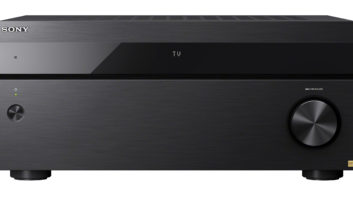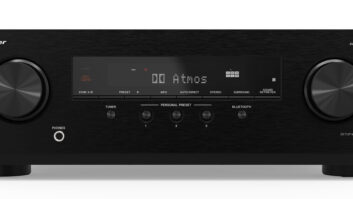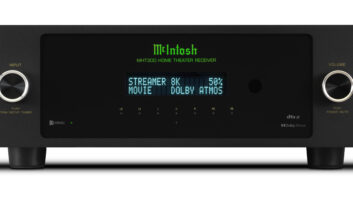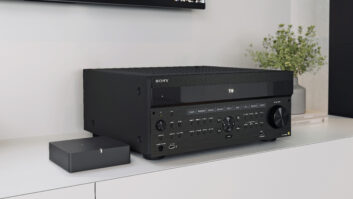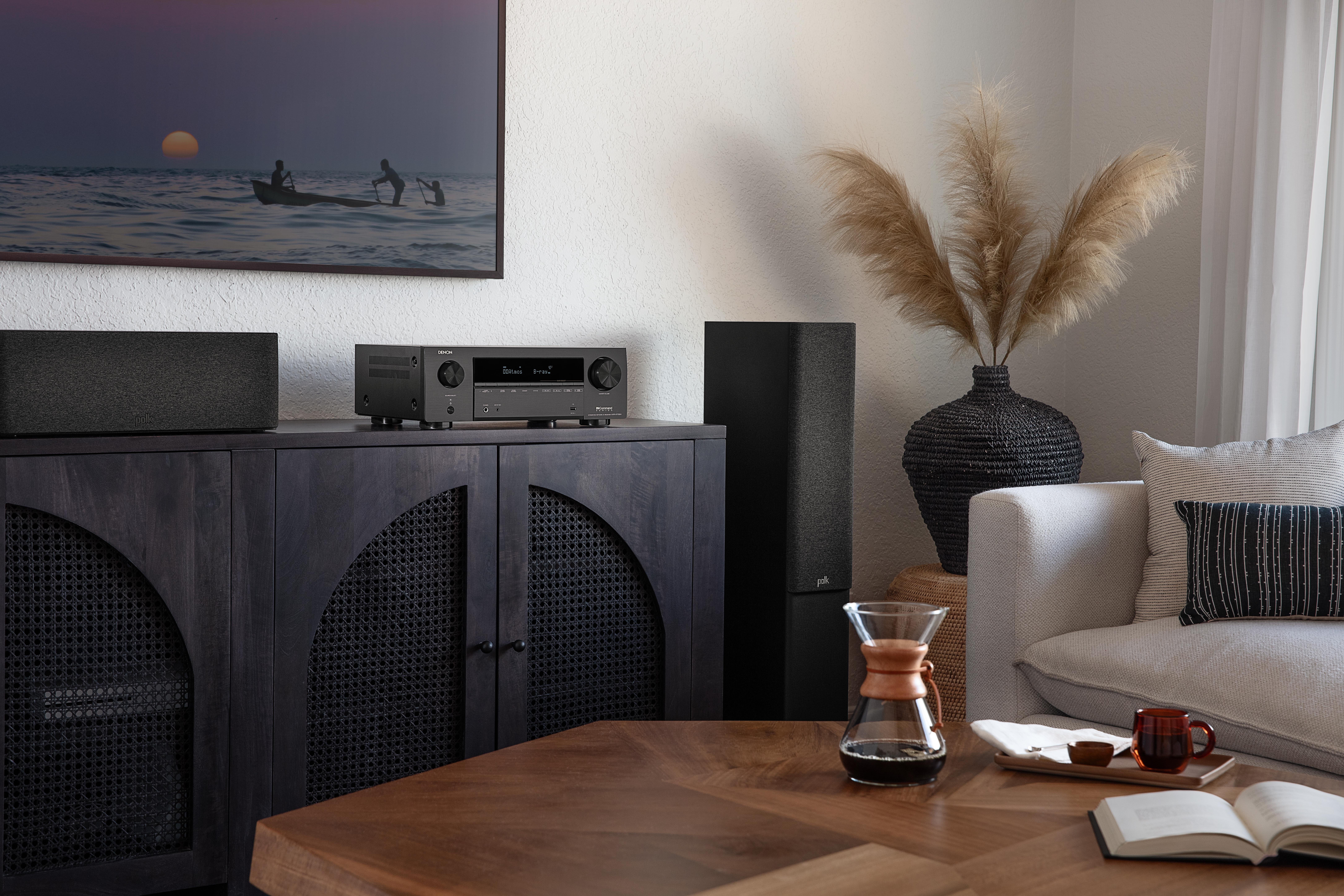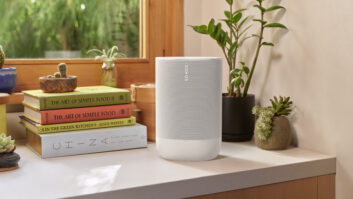Kudos: Terrific build quality, 360 SSM increases surround spaciousness, Sonos integration
Concerns: Casting issues, quirky 2.1-channel handling
If you’re a Sony dealer, you’ll know that along with flat panels and projectors, the company’s AV receivers comprise one-third of the Holy Trinity required for earning the coveted “Diamond Dealer” status. However, it has been nearly six years since the company updated its flagship ES (Elevated Standard) receiver lineup, and almost a year since any of the previous models were in stock and available to order, leading many to think that a refresh was imminent.
However, after both CEDIA and CES passed without any announcements, it was fair to start wondering if maybe Sony was abandoning the receiver market.
Nope.
Not only is Sony back in the AVR game, it has returned with a vengeance, delivering its strongest lineup of AVRs ever. The new model line includes four models ranging from $1100 to $3300 MSRP, all offering some of the most requested features custom installers have been asking for, with performance and capabilities that punch way above their price. (I’d say “above their weight class,” but, as you’ll read later, they are already virtually in a class by themselves when it comes to that!)
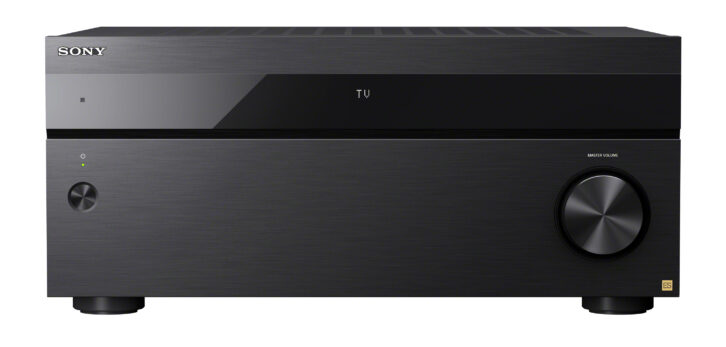
Being Sony, the new model numbers can lead to some confusion, as they are almost identical to a previous generation short of flipping two letters, now AZ instead of ZA. However, Sony has made it pretty simple to select the best model for a project, as the units begin with the 7.2-channel STR-AZ1000ES and increase by two channels of power and processing with each model step, up to the flagship 13.2-channel STR-AZ7000ES. (Higher-end models also benefit from additional amplification power and other features.) For this review, Sony sent the STR-AZ3000ES, a 9.2-channel capable unit that will likely be one of the most sellable in the line.
Appearance
My review sample arrived before I’d had any briefing on the product, so I had no idea where this model fit into the new lineup. And, to be honest, the 3000 model number — which had previously been the flagship number of Sony’s ES lineup — coupled with the weight of this unit made me think this was the flagship model, not near the entry in the ES lineup!
I know that weight isn’t automatically a guarantee of quality in a receiver/amplifier, but it certainly speaks to build quality, especially when it comes to having beefy power transformers, power supplies, and a significant chassis. In an era where we’re increasingly seeing gutless digital amplifiers that weigh nearly nothing, this Sony is a Titan. Weighing in at over 41 pounds, the 3000ES feels like a serious piece of electronics right from the jump. I believe my first words when grabbing the box were, “Oh, damn.”
Seriously, when I brought it into my store, part of my “sales pitch” was just having people lift other AVRs and then lift the Sony. To a person, they all reacted with, “Wow!” As a comparison to other 9-channel AVRs, the Marantz Cinema 50 is 29.8 pounds, the Denon AVR-X3800H is 27.6 pounds, and the Onkyo TX-NR7100 and Pioneer VSX-LX305 Elite are both 22.9 pounds. (Respect to the Yamaha RX-A6A for its 41.2 pounds!)
Part of this weight comes from a newly designed frame-beam base chassis that Sony has fundamentally revised for this lineup. The overall thickness has been increased for improved rigidity, and other parts have been redesigned to improve build quality and deliver sonic improvements.
While many manufacturers have adopted a “less is more” approach to front-panel design, often featuring just a volume knob, input selector, and power button, Sony has retained its “more is more” design with the front panel having a myriad of buttons capable of accessing or accomplishing nearly any feature the receiver is capable of. Fortunately, every button besides power and the volume knob are concealed behind the removable front panel, leaving a very clean and streamlined look when in use. Sony offers optional rack ears (WSRE2) if it will be rack-mounted.
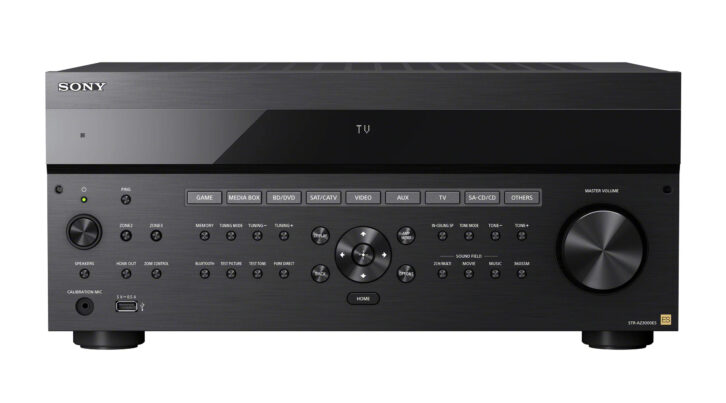
On the one hand, all these buttons can be a lot to take in, but on the other, if a tech or a customer needs to do some troubleshooting, these buttons coupled with the informative front-panel display, will put everything needed at their fingertips.
The front LCD display conveys a wealth of information, giving you a quick glimpse into what the receiver is doing.
Sony has also kept the front panel devoid of any logos or other clutter. Short of a simple gold ES badge, the receiver’s appearance together with its heft make it look like a fully competent professional ready to get to work. The ES Badge also means it comes with Sony’s full five-year warranty, which is nothing to sneeze at.
Installation
Considering the number of inputs and connections available, the 3000ES’s rear panel is actually not overly crowded and leaves plenty of room to work and make connections. However, besides its weight, the receiver’s overall size is pretty hefty, and at almost 17.5 inches deep, you’ll need to make sure your cabinet/rack is up to the task.
Sony has followed the modern design trend of arraying the speaker connections in a row along the bottom of the receiver — with the exception of the Height 1 connections, which are above the front channels — using binding posts that will accept banana plugs. There are two RCA pre-outs for connecting subwoofers, but no pre-outs for any of the other channels. (Both the 5000 and 7000 models include full sets of pre-outs if you need that feature.)
For the ultimate in flexibility and Sony-on-Sony integration, there are a couple of other features to the new ES line. For one, this receiver sports the S-Center out connection we’ve been seeing on recent Sony soundbars, which allows you to use the speakers in certain Sony displays to augment the center-channel audio. For another, you can also integrate Sony wireless surround speakers and/or subwoofers with this unit. It supports both the SA-RS5 and SA-RS3S, which can be used as surround or surround back speakers. (When using the SA-RS5, it will also act as an upfiring height speaker.) On the subwoofer front, you can connect up to two of Sony’s new wireless subwoofers, models SA-SW3 or SA-SW5. (Note: You can’t have one wired and one wireless sub.)
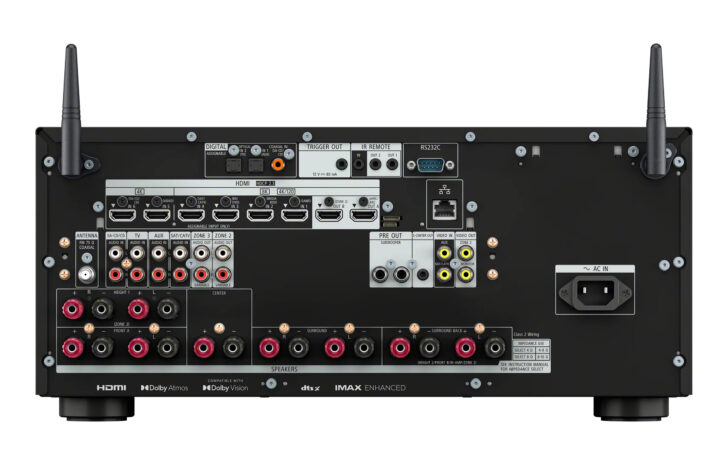
Once connections are made, there are a variety of ways to get into the receiver’s configuration settings. You can either use the front-panel display, the on-screen GUI, or a computer. (Note: When my unit first arrived, the pre-release firmware didn’t allow for network setup, but near the end of my review, Sony provided an update that enabled this feature, along with integration with the Sony Music Center app.) For initial setup, I prefer to use the smartly designed OSD; however, after that, the web-based control gives you access to every setting and configuration without having to wade through the menu tree and is way faster for things like relabeling inputs.
For speaker configuration, Sony uses a speaker pattern layout where you first select how many floor speakers are in the system ranging from two to seven, then select height channels — either two or four in various combinations of Front Height, Top Front, Top Middle, Front Dolby, Rear Height, and Surround Dolby speakers. From an Atmos standpoint, this receiver can support up to 7.2.2 or 5.2.4.
Depending on how many speakers you are powering, you can use the receiver’s extra internal amplifiers to power Zone 2 and/or Zone 3, or you can use a separate power amplifier with the Zone 2/3 pre-outs. While a CI probably won’t need the handholding, I really liked the multi-zone OSD, which clearly walks you through the process of what and where you need to make connections for multi-zone watching and listening. The unit also features a Zone 2 DAC that will downconvert HDMI and digital audio content for output to Zone 2.
Looking to the future, this receiver sports six HDMI inputs and two HDMI outputs. Four of the inputs (and both of the outputs) are HDMI 2.1/HDCP 2.3 supporting 8K/60 and 4K/120 video. The main HDMI output supports eARC, and the second output can either mirror the main or be used for a second viewing zone.
For legacy connections, there are three digital audio inputs (two Toslink, one coaxial), four sets of RCA analog inputs, and two composite video inputs with main and Zone 2 composite video outputs. (Is anyone still using these? Seriously. Send me an email, I’d love to know.) Despite the vinyl resurgence, there is no Phono input — or ground terminal — so you’ll need a phono pre-amp to spin your records.
On the control side, the receiver supports Control4’s SDDP, Crestron, Savant, and OvrC. There is also a DB9 RS-232 connection, as well as a rear-panel mini-jack IR input and two mini-jack IR outputs. There is also a 12-volt trigger that could be used to power a Zone 2/3 amplifier.
Another of the receiver’s super-handy tricks is found under the Network Settings tab, where you’ll find the “Works with Sonos” option. The unit will look for any Sonos devices connected to the same network, and then you can “pair” them to the receiver. Once done, when the receiver senses that the paired Sonos device is playing music, the receiver will power on, switch to the designated input source for playback, and go to a preset volume level, allowing the user to do everything from the Sonos app. The receiver supports connection of two separate Sonos components, allowing you to have one for the main zone and another for Zone 2/3.
Once connections are made, you can break out the included microphone and tripod and run the auto-calibration. While this microphone looks the same — with two separate left and right capsules — as that included with previous units, this includes the latest version of Sony’s Digital Cinema Auto Calibration IX. It also includes a couple of interesting twists to the measurement process, having you measure and input some information prior to running the test tones, such as screen distance to listening position, listening position height, ceiling height, and center of screen height.
After entering this info, the unit runs a series of test tones and then prompts you to rotate the microphone 90 degrees before running the tones again. Following this, it calculates levels and distances from the listening position to each speaker, distance of each speaker to screen, and the height of each speaker, which were all spot-on down to the inch.
The microphone uses these two measurements to measure your room in 3D, which is an improvement over previous versions of auto-calibration that only utilized a 2D measurement. According to Sony, “The 3D measurement helps to ensure that the speakers are best calibrated to take advantage of Sony’s 360 Spatial Sound Mapping technology. It also uses these measurements to ensure speaker relocation and Automatic Phase Matching are optimized for the room that the receiver is in.”
Once calibration is complete, you can choose whether or not to enable Automatic Phase Matching, enable one of three calibration types from Full Flat, Engineer, or Front Reference, or use the surround speaker repositioning feature. One cool thing is that you store two completely separate speaker profiles and calibration presets, say, one that is a full 5.1.4 Atmos and a separate one that is just 2.0 for stereo listening, possibly even in a different seating position. This makes it a simple process to switch between the two settings for the best experience.
Following calibration, the system “knows” each speaker’s position in relation to the screen center and the listener’s position, and the 3000ES can use this information to enable a couple of other options that might be of value. The first is Center Speaker Lift Up, which can help to raise the height of the center speaker by mixing some of the audio into Front Height speakers if present. Smartly, this has a selectable level of 1 to 10, letting you dial in the best results in your room. The second is In-Ceiling Speaker Mode, which can lower the audio position if using in-ceiling front channels.
Two other helpful features carried over from previous Sony AVRs are the Ping button and the Picture Test feature. The front-panel Ping button is a great way to quickly get the unit’s IP and MAC address, and is terrifically helpful when remotely troubleshooting something with a client. Not quite as helpful is the front-panel Picture Test button, which just outputs a 480p image. (In the past, you could keep pressing this button and it would toggle resolutions.) Now, you need to go into the installer settings menu (either on the unit or via the web GUI), where you have selectable output resolutions up to 8K/60 and 4K/120 for both HDMI A and B outputs, which is a fantastic way to troubleshoot any issues in the signal chain.
Finally, this new receiver supports Sony’s Music Center app, which is quite handy for selecting inputs, adjusting volume, or jumping into settings like selecting a sound field or tweaking the level of a speaker.
Performance
While the Sony doesn’t have any native streaming support built-in, there are plenty of ways to send music to it, including Google Chromecast, Spotify Connect, Apple AirPlay2, or Bluetooth. If using a service like Amazon Music or Tidal that supports 360 Reality Audio, you can cast that to the 3000ES, as well. And using the Music Center app, you can also browse music stored on the home’s network.
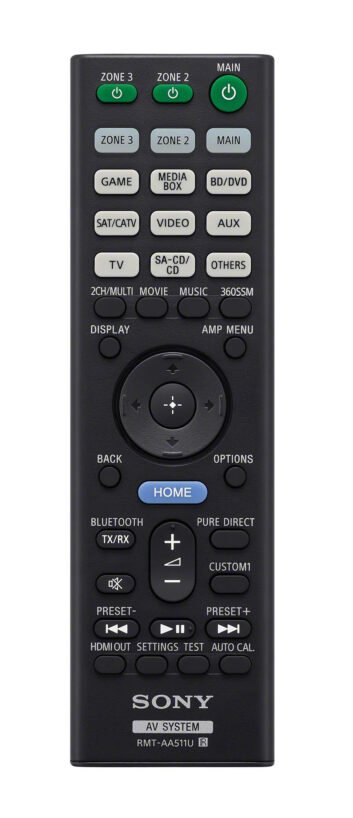
However, I found that the unit often did not appear as an available device under the Chromecast or AirPlay speaker list. Even though several other Sony devices on the same network (TVs, a soundbar, and an older receiver) appeared 100 percent of the time, the AZ3000ES was often MIA from the list. Sometimes it would even disappear from the list while it was being casted to! Usually, I could just wait a few minutes and then it would reappear, or a hard power cycle usually brought it back. I’m hoping this is a quirk of my model, or something that can be resolved in firmware, but it happened too frequently not to mention.
To get a feel for the AZ3000ES’s capabilities, I first connected it in stereo to a pair of Monitor Audio Silver 500 7G towers and Chromecasted music from Tidal. Right away, I got a sense of the receiver’s ability to deliver real dynamics, detail, and low-end punch. It was able to produce tactile bass from the towers, but also had plenty of control and attack on Michael Hedges’ “Rickover’s Dream” and “Ragamuffin” from Aerial Boundaries with headroom to spare
From there I added in a Monitor Silver W-12 6G subwoofer and reran the audio calibration, which played a variety of tones and frequencies to analyze the subwoofer. Putting the unit in 2-ch Stereo, I noticed there was no output from the subwoofer, which exposed a bit of oddness in Sony’s sound-field processing modes. Consulting the online owner’s manual — and experimenting in real life — I determined that you can only get 2.1-channel audio by selecting A.F.D (Auto Format Decoding). Unfortunately, the receiver’s purest listening mode — Pure Direct — won’t feed the subwoofer with 2-channel content either. This mode lowers the noise floor by defeating the front-panel lighting, as well as some of the processing (Automatic Phase Matching, Calibration Type, Equalizer, In-Ceiling Speaker Mode, and 360 Spatial Sound Mapping).
From there I connected a 5.1.2-channel Atmos speaker suite, reran the calibration, and connected a Kaleidescape Strato and 85-inch Sony 4K TV for some serious movie watching.
The cohesiveness of the surround presentation really impressed, with my favorite demo scenes from Top Gun: Maverick, Ready Player One, and Kong: Skull Island delivering the big overhead thrills, front-to-back pans, and dynamics I expect, and dialog was always clear and focused. (Well, except for Tenet. I still haven’t found a processor/speaker combo that cleans up that mess.)
After running the auto-calibration, you are able to turn on the 360 Spatial Sound Mapping (SSM). I had previously experienced this with some of Sony’s soundbars, where it definitely increased the surround effect, but this was the first time I’d hear it in a full surround system, and I was definitely impressed. Sony describes this as making “the sound feel more spacious and as if there are more speakers in the room,” and it definitely expands the sense of air and feeling of being enveloped in sound rather than being surrounded by speakers. Especially with the 5.1.2 system I was using — with SSM engaged, it created a convincing side surround image, producing much better cohesion between speakers. Movies with lots of small, scene-establishing atmospherics like the big, open outdoors in A Quiet Place Part II felt bigger, and the cars racing by and even distant tracks sounds in Ford V Ferrari just sounded fuller and more convincing.
Similar to the richer OSD integration with recent Sony TVs and soundbars, the 3000ES also allows from some on-screen selection of sound mode and turning SSM on/off using the TV remote.
As I’m in the midst of testing the new Mark Levinson No.5909 wireless headphones, I paired them with the 3000ES and gave a listen. When watching Kaleidescape TrueHD Atmos content, there was the slightest bit of audio delay when using BT (LDAC) from the receiver to the Levinsons, though definitely not enough to make it unusable.
When I reviewed Sony’s first foray into a CI-centric AVR, the STR-ZA3000ES, eight years ago, I had this paragraph listing its shortcomings:
There are some things notably missing from a receiver at this price. For one, there are no music streaming capabilities at all. No network audio, no USB audio, no Bluetooth, no AirPlay. The receiver also doesn’t support Dolby Atmos. There is no app for phone or tablet control. And the receiver can’t be firmware updated or backed up across the network, rather requiring a front-panel USB connection.
With the new ES lineup, Sony has not only addressed all of these shortcomings, but they’ve done it at highly competitive price points and delivered products you can confidently install in a client’s home without hesitation. Give the AZ3000ES a listen, and I daresay it is likely to become your go-to solution for any of your 9-channel installs.
877-865-7669; SONY.COM
Product Specs:
- 2-channel AV Receiver with 120 watts/channel
- Decodes all major surround formats, including Dolby Atmos, DTS:X, and IMAX Enhanced, as well as Hi-res audio up to 96/24 and 360 Reality Audio
- Google Chromecast built-in; also supports Spotify Connect, Apple AirPlay 2, and Bluetooth
- Ready for next-gen HDMI formats, including 8K and 4K/120
- Wired and Wireless (802.11 a/b/g/n/ac) network connection
- “Works with Sonos” for easy integration
- Supports Control4 SDDP, Crestron, Savant, and OvrC
- Inputs: Six HDMI inputs (four 8K and 4K/120 capable), two composite video, three digital audio (two Toslink, one coaxial), four RCA analog audio, Ethernet, mini-jack IR, RS-232 DB9, 75-ohm FM antenna; Outputs: two HDMI 2.1/HDCP 2.3 (8K and 4K/120) one with eARC, two RCA subwoofer, RCA analog Zone 2 and Zone 3, two composite video, mini-jack S-Center Out, 12-volt trigger, two mini-jack IR outputs; detachable power cord
- 5-year Sony ES warranty
Dimensions:
- 17 x 7.75 x 17.375 inches (WxHxD)
- Weight: 41.2 pounds
